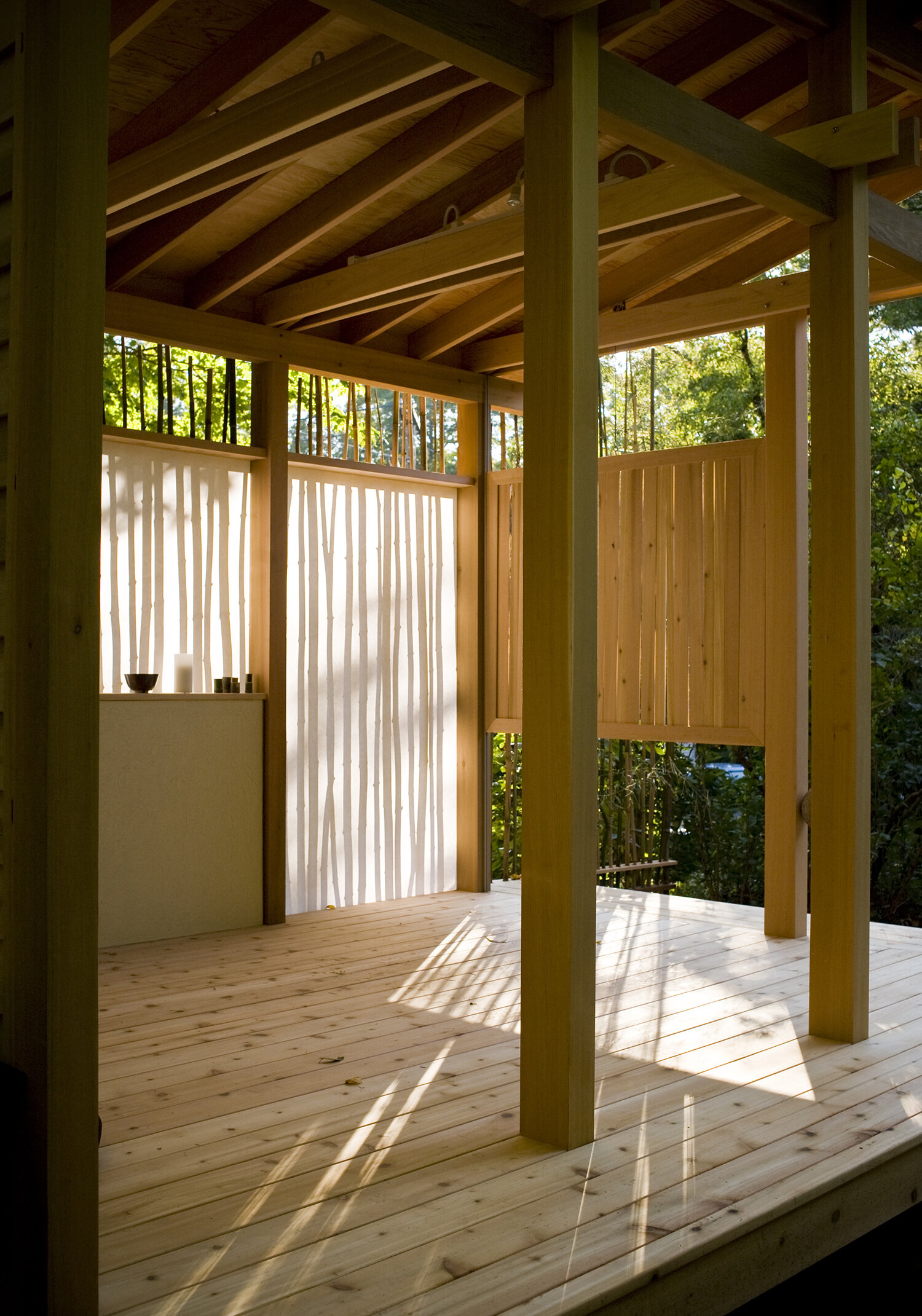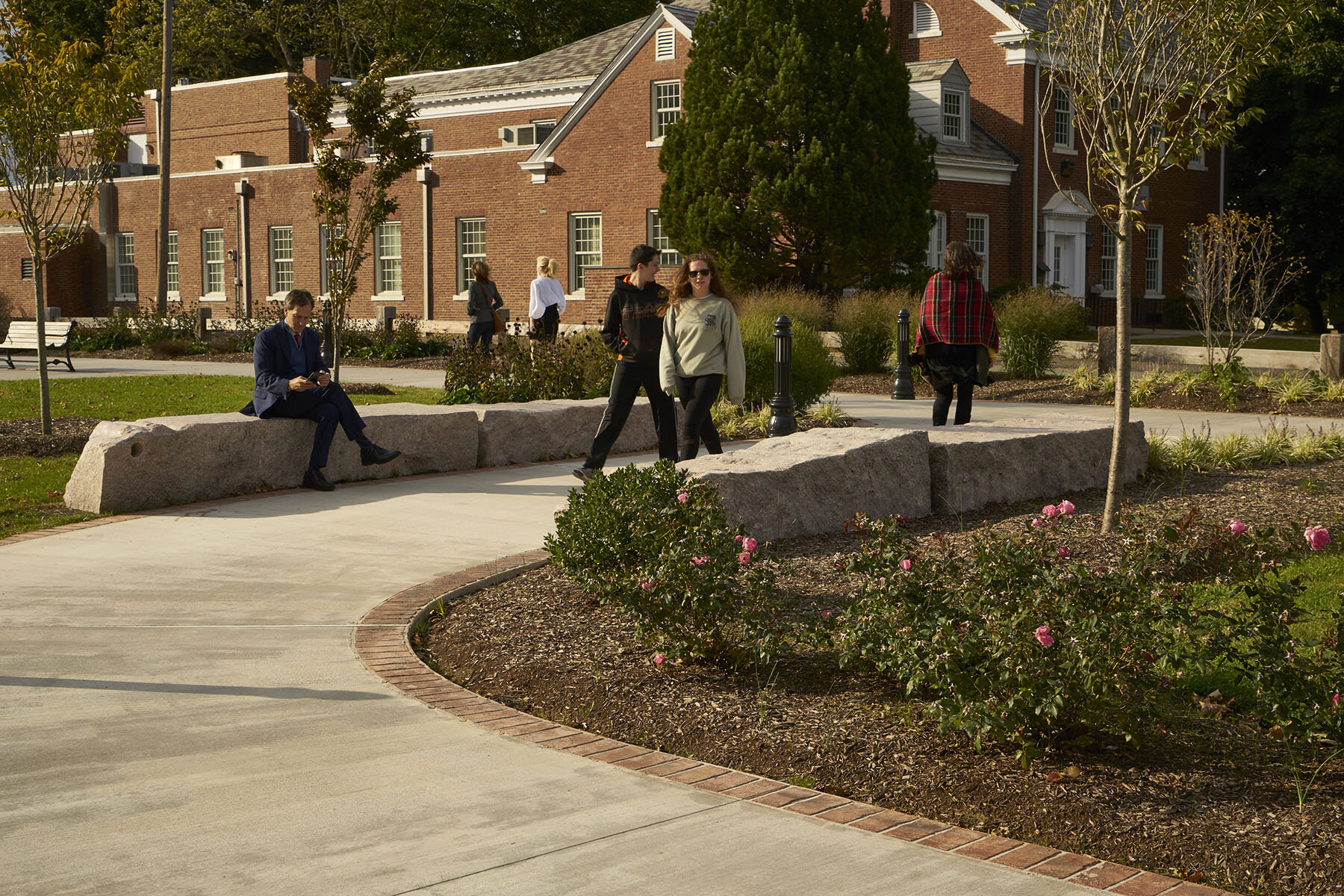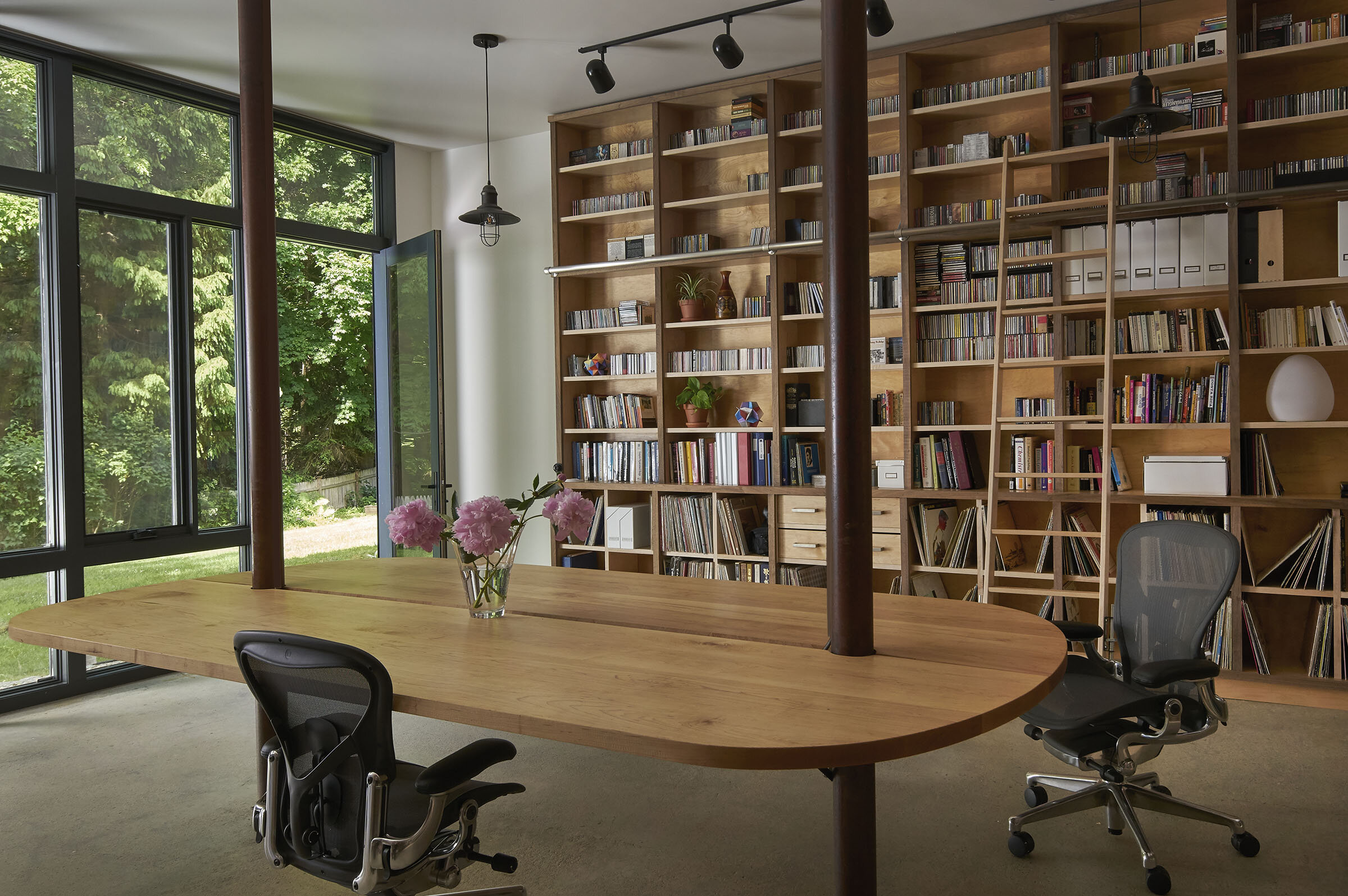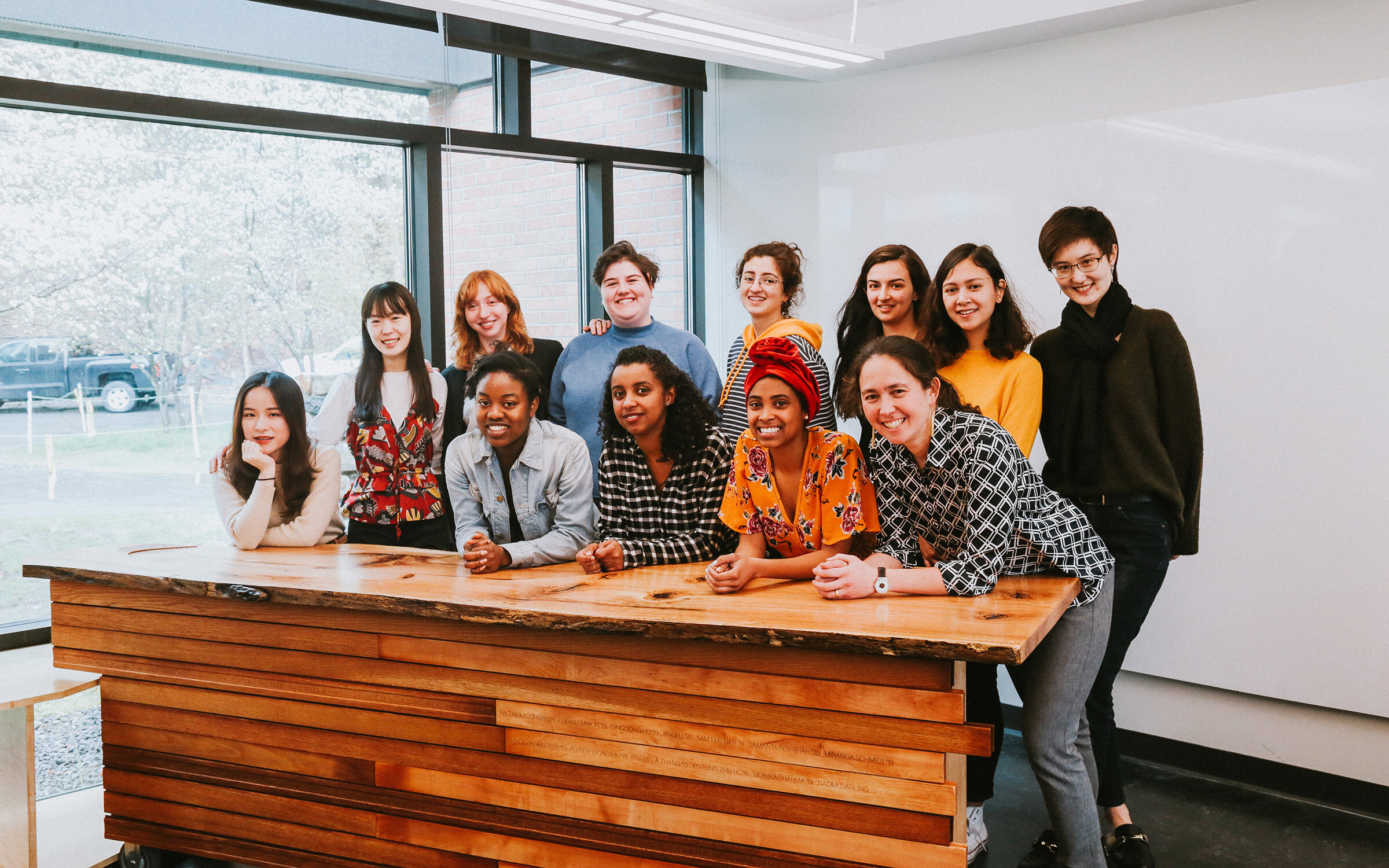Solid Foundations: Naomi Darling on her Commitment to Sustainability, Managing her own Expectations and to Doing More With Less
By Julia Gamolina
Naomi Darling is founding principal of Naomi Darling Architecture and Five College Associate Professor of Sustainable Architecture. Darling’s research and award-winning professional practice develops projects at all scales in terms of size, time and permanence, and students are often engaged in real sites and programs. Permeating all projects is a dimension of environmental stewardship, social responsibility and the role of architects as agents of change. Current projects include a Kayak Kiosk and Picnic Pavilion for Sunderland, a Bandshell for the town of Amherst, several residential projects, a farm stand and seed library in Nan, Thailand and Nitobe Memorial Hall, a museum, library and community center in Sapporo, Japan.
Naomi received a BSE degree from Princeton University in structural engineering and architectural design, an MFA in sculpture from Monash University and a Masters of Architecture from the Yale School of Architecture. In her interview with Julia Gamolina, Naomi talks about her interest in and commitment to sustainability, and how she integrates her practice with her teaching, advising those just starting their careers to pay attention to what is happening and ideas stemming from outside disciplines.
JG: How did your interest in architecture first develop?
ND: I was raised in a bi-cultural home with two art historian parents. My Japanese mother was working on her PhD in French Romanesque art history and my American father was working on Medieval Japanese mandalas. This led to me growing up in both countries with very different cultures and daily patterns of living. When we lived in Japan when I was in grade school, we would often visit my grandmother who lived in an apartment upstairs from the family restaurant supply store in Asakusa, Tokyo. Half of the apartment was tatami mats while the other half was furnished in a more western style.
I saw very early how culture shapes space and how the spaces in turn shape our lives. Some of my most vivid memories from my childhood are from the summer I turned ten. We spent months in a Renault 5 driving around France visiting Romanesque and Gothic churches as part of my mother’s research. As a child our memories are so visceral and I can still almost feel the cool dampness of the stone and hear the quiet, the echo of footsteps in the small churches that we visited. My love of materials – stone, wood and bamboo – can be traced back to these early experiences.
Kernan Tea House, photography by Sean Kernan
Kernan Tea House Interior, photography by Sean Kernan
You are also deeply committed to sustainability and climate change. How did this interest develop?
In my senior year of high school, I was selected as a National Science Foundation young scholar to participate in an NSF Young Scholar Antarctic Research Experience. I was paired with a sea ice physicist at Dartmouth/CRREL (Cold Regions Research and Engineering Laboratory) and we were part of an interdisciplinary team studying climate change in the Weddell Sea. It was very powerful to be in a place where life is so fragile. In the 40 deg below Fahrenheit temperatures, I experienced the raw power of the landscape while understanding how our everyday choices are impacting the health of all ecosystems and the life they support. Ever since, climate change and sustainability have been an integral part of my mission.
What did you learn about yourself in studying architecture?
As a freshman at Princeton, I took an intro architecture studio with Liz Diller and I loved how the course expanded my way of thinking demanding thoughtful reasons for the myriad decisions that go into design. I decided to major in architecture and perhaps unusually, I opted to transfer into the engineering school where I majored in Civil Engineering and Architectural Design with Professor David Billington. I learned to appreciate a beauty of efficiency and simplicity in design, material use, and structure. For my senior thesis I combined my passion for Antarctica with design through developing a CFD model for snow drifting - this was the beginning of my thinking about designing for climate and place.
I had a few more explorations before committing to architecture. I apprenticed to a potter in Kita-Kyushu, and to a ceramic sculptor in Hagi, Japan. I spent time as an assistant scientist on a 125’ schooner working for Sea Education Association, and I did an MFA in sculpture in Melbourne, Australia. Through these experiences I realized that I wanted to be able to create work with the potential to impact more people and communities. I also learned that I have a deeply engrained sense of doing more with less – using the materials around me and trying to maximize the potentials in a project. This was the case in my sculpture, and perhaps even more so now as an architect.
“I learned to appreciate a beauty of efficiency and simplicity in design, material use, and structure...I have a deeply ingrained sense of doing more with less.”
How did you get your start in the field?
My first architecture job was at Olson Sundberg Kundig Allen Architecture in Seattle back in 2000. I am very lucky that OSKA was my first work experience and it is definitely what convinced me to continue in the field and go to graduate school. As an undergrad at Princeton in the 1990s, the studios were conceptually rigorous and my work stayed in the more abstract realm. At OSKA, working on the Larson Cabin, aka the Think Tank, was a turning point for me because I was able to participate in the entire process from the initial idea to detailed construction drawings. Seeing the project complete was a thrill. The thing about OSKA that I am thankful for to this day is how I was able to participate in an office that was very well run and allowed time for people to have families and outside interests. We also had a great mix of institutional, public and residential work that remains my ideal.
After graduate school, I moved to Tokyo to work for Kengo Kuma and Associates. Kuma ran his office like an advanced graduate studio giving his employees incredible design freedom and autonomy. This contributed to how invested everyone was in their projects. The work culture in Japan was pretty intense and here I was struck that almost all of the few women in the office had international experience and none of the women had children. Returning to the US, I worked with Studio ABK in New Haven. The partners had all worked together for many years at Cesar Pelli’s and I was able to participate in the start of a new office.
Old Saybrook Park, photography by Sean Kernan
Naomi selecting granite for Old Saybrook, photography by Darrell Petit.
Tell me about launching your own practice.
Right after grad school, before moving to Tokyo, I completed my first project, a tea house. At the time I was working as a TA for the Yale building project and so I decided to do the project as a design-build. It was the perfect first project at a scale that enabled me to focus on siting, light, views and materials. It also gave me a taste of working for myself, steering a project from gazebo to tea house and nurturing the relationships with both the client and craftspeople who worked with me.
I decided to launch my own practice after our first son was born. I had known since my time in Seattle that I wanted to combine a career in teaching with my own practice and the timing worked out such that while on maternity leave, teaching opportunities at Yale and Brown came along and then my tea house clients asked if I could design a photo studio – the stars aligned and I’ve been teaching and practicing ever since. Teaching adjunct for several years confirmed my love of teaching so I decided to apply for tenure track teaching jobs in architecture. I wanted more agency to shape a curriculum and the flexibility and financial stability to choose interesting projects.
In 2012, I arrived in the Five Colleges Consortium just as a shared five college architectural studies major was formalized. I have just received tenure as the first architecture studio professor in a shared appointment at Mount Holyoke College, the oldest women’s college in the country and UMass Amherst, the only public architecture school in New England! I feel very fortunate to have landed here.
“Climate change is the biggest issue of our time and an issue that as architects, we have the ability to impact. Addressing this challenge, the profession needs the voices and vision of as broad and diverse a group of people as possible.”
Congratulations! With this new exciting step, where do you feel like you’re in your career today?
Having just received tenure, I feel it’s metaphorically like having built a solid foundation from which I can continue to grow. I have been balancing a career in academia with a professional practice while also managing the work-life balance with young children. I’ve been lucky that in my shared position between Mount Holyoke College and UMass Amherst, I didn’t have to choose between becoming an academic or being a practitioner – something that is becoming increasingly rare. For me, I felt that academia was the place I could have the biggest impact by teaching core beliefs integrating sustainability into the conception of projects to generations of students who will go on to practice around the world.
In this next phase, I am looking forward to continuing to build my practice both locally and globally to address the power of design located at the intersection of climate, culture, and materiality to create transformative, uplifting spaces. My professional work falls roughly into three categories: private residential work, public projects including competitions and art installations. Working across project types and at different timelines enables ideas to iterate more quickly as work from one category informs another. A private residential project may take one to three years, a public project may easily take five to ten years, while an art installation can be designed and installed in six months. All of my projects are united by a commitment to sustainability, the details of construction, and respect for the site and context.
Looking back at it all, what have been the biggest challenges?
The most challenging year of my career was my first-year teaching on tenure track in the Five Colleges consortium. I needed to figure out three campuses - Mount Holyoke College, UMass Amherst, and Hampshire - with very different cultures, we were commuting between Connecticut and Western Mass, I had a project under construction, we had a 3-year-old and I was pregnant with horrible morning sickness. I was trying to do too much! This points to a larger challenge of managing my own expectations and learning to rely on others when possible. Running a solo practice while teaching continues to be challenging and I am gradually building a network of trusted collaborators.
Takahashi-Harb Library, photography by Sean Kernan.
Takahashi-Harb Loft, photography by Sean Kernan.
What have been the highlights?
The successful completion of every project is a highlight. I tend to be most excited about what I am working on at the moment and what is still to come. Right now, I have two public projects underway with my UMass colleague Ray Kinoshita Mann - a Kayak Kiosk and Picnic Pavilion for a local public library and a Performance Bandshell for the Amherst Town Green. These are exciting because they are both public projects that will serve the community. Another rewarding project has been the pocket park in Old Saybrook, CT on Main Street that was supported by a Small Town Economic Assistance Program grant from the state. This project was completed in collaboration with my husband, Darrell Petit, who sculpted the granite elements. When the first selectman says that there are always people using the park and that it has become a gathering point in town, it is rewarding. In 2014, I won an international competition to design Nitobe Memorial Hall, a museum and community center in Sapporo, Japan. It has always been a dream to work in Japan so I am hopeful that the fundraising efforts underway will be successful. Right now, I’m also working on an addition to a mid-century modern house for two art historians and the retrofit of a shipping container as a “crash pad” for Darrell so he can overnight at the quarry, his studio.
One highlight at Mount Holyoke College has been the building of a makerspace where I teach a Design-Build class each spring. In the first iteration of the course, I worked with thirteen students and they were so empowered and proud of what they learned and accomplished! Young women still don’t have the same exposure to shop facilities and many Makerspaces can feel uninviting. I think it was important that I was the one teaching the class and not a man as typically happens. A final highlight is a class that I co-taught with my anthropologist colleague Professor Sue Darlington and Phimonphan Sakitram, director of the non-profit in Nan, Thailand that we are working with. Together, with an interdisciplinary group of students studying design, the social sciences and ecology, we developed proposals for JOKO, an NGO in Northern Thailand that works to promote small scaled integrated organic farming and seed saving. Student teams developed several concept design proposals for a seed library, farmer’s market and café. Although we can’t travel now (due to COVID), this is a project that I hope will move forward and is a direction I am hoping to pursue in this next phase of my career. I believe as architects we need to be bridges between different disciplines and user groups to help build a vision for a sustainable and equitable future. This project modeled that through the team teaching that we did and intentionally bringing together students from different disciplines and campuses.
“I have had students write in their course evaluations that they appreciate having a female architect as their professor because the majority of the architects that they have studied in their modern architecture classes are men.”
Who are you admiring right now and why?
Since the lockdown started, I have been reading more fiction and The Overstory by Richard Powers has made me look at and think about trees, and time, differently. There’s one quote in which one of the characters, makes a challenge: “What you make from a tree should be at least as miraculous as what you cut down.” (p464) Although I don’t know that we can make anything as miraculous as a tree, I do believe that we need to honor the life of the tree with everything we make from it. To me, this applies to all of the material resources that we extract from the earth. The book also made me realize that today humans, homo sapiens, are changing life on earth from a biological and ecological standpoint more rapidly than at any other time in recorded human history. Some of the changes brought about by the pandemic including less travel are very good for the planet and I am hopeful that some of these changes will be long lasting.
I am also inspired by my students and the next generation of architects, designers and citizens. So many young people are coming into our field to make the world a better place – to address the climate crisis, to address inequities in our society that can be impacted through the built environment, to make life better for everyone. They are the future and we have a responsibility to role model the potentials of the power invested in us as the designers and builders of the world that we all inhabit.
Along these lines, I really admire what you are doing with this website and highlighting the work and careers of women architects. It’s something that has been missing in the history of architecture and I have had students write in their course evaluations that they appreciate having a female architect as their professor because the majority of the architects that they have studied in their modern architecture classes are men. I think this website is part of the change that we need to see in the profession to tell the stories of a more diverse group of practitioner and thereby nurture a more diverse next generation.
Naomi at MHC with students in Design Build class on pivoting greeter desk project. Photography courtesy of MHC.
Naomi in Antarctica, on the RV Nathianel B Palmer, 1994.
Naomi, thanks so much for sharing that. That means a lot to me, and is precisely why I do what I do.
As to your “why”, what would you say is your core mission?
My core mission is to address the climate crisis through the built environment and to increase the diversity of voices who are in positions of power to effect these changes. Climate change is the biggest issue of our time and an issue that as architects, we have the ability to impact. Addressing this challenge, the profession needs the voices and vision of as broad and diverse a group of people as possible.
I am privileged to be able to teach at Mount Holyoke College and UMass Amherst. At both of these institutions, I feel that I am able to contribute to diversifying the profession. Mount Holyoke College is the oldest women’s college in the country and my architectural studies students are women, women of color from the US as well as a large number of international women of color from Africa and Asia who will return to their home countries to work in architecture, planning and of course other disciplines. When I look out at my classrooms, I like to think that I am looking at the future of our profession.
In addition to helping to change the demographics of people who are the future designers of the world is to instill the idea that sustainability thinking needs to be there right at the beginning of every project. I teach my students that understanding where you are working on the earth’s surface in terms of climate and material and spatial culture is just as important as learning how to draw. This is something that I hope becomes foundational to their design thinking.
Finally, what advice do you have for those starting their career? Would your advice be any different for women?
To my students and advisees, I always recommend that they take classes outside of architectural studies in areas that interest them – architecture only serves to gain when we have a broader understanding and interest in people, places, and the way the world lives. Ideas from outside disciplines will make our designs stronger and the resultant projects will be richer for it. Perhaps this is why I love teaching in a liberal arts college so much!
For those just starting out, the first job is really important and I think it is worthwhile to take the time to find a firm that is a good fit. I got really lucky at OSKA for the reasons I outlined above and I tell my students to ask firms if they can meet with younger interns in the offices they are interviewing at to see if they are happy.
For women, I think the main thing that is different is the timeline if you want to have a family – I was pregnant when I was thirty-five and thirty-nine, and my second pregnancy was much harder than my first. There’s a biological reason that it is harder to get pregnant as an “advanced maternal age” mom! The profession loses too many women around the critical life stage of motherhood. I think, especially in the US, you have to be well enough established that you are able to get the flexibility that you may need. This means if as a young woman you know you want to be an architect, invest in yourself and your career so that when you need to adjust due to family demands you can keep doing the work that you love. In fact, this applies to men who want to become fathers as well! Although it’s hard – don’t be deterred! It’s amazing.
Finally, value the thinking and skills that come naturally to you. I have at times tended to dismiss those things that seem too easy as not having value but in fact by celebrating our strengths, we are singing in our own unique voices.
This interview has been edited and condensed for clarity.








